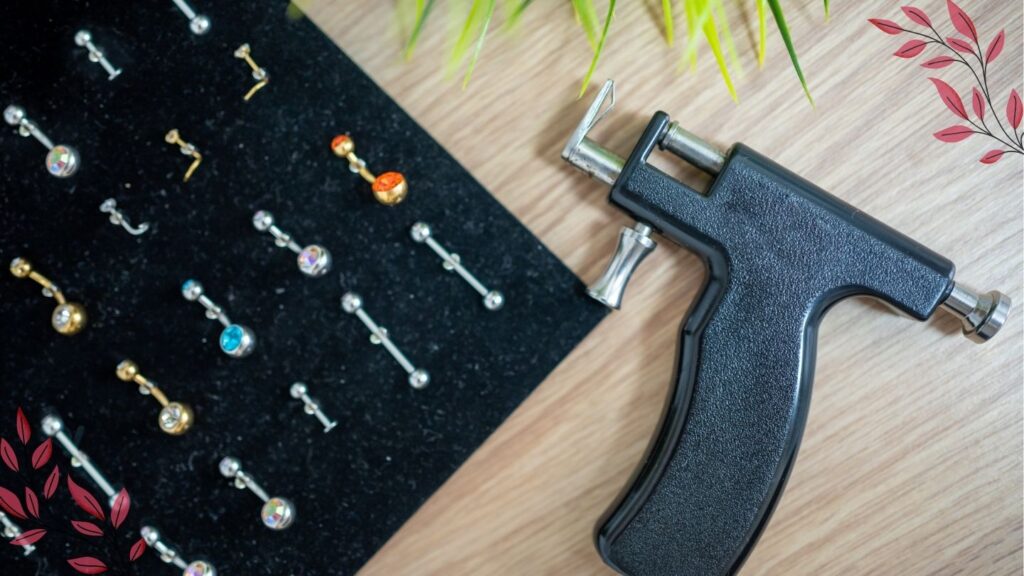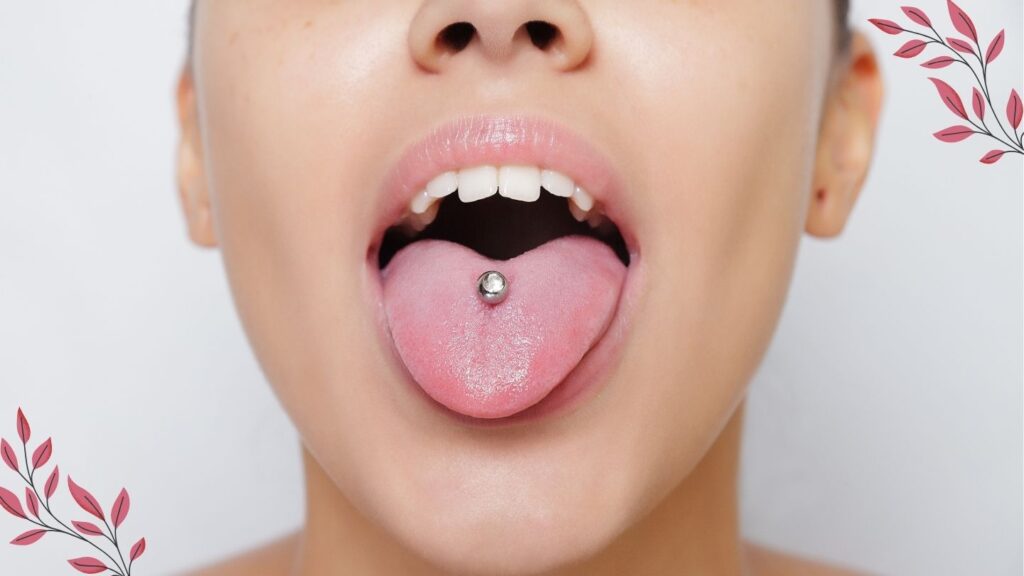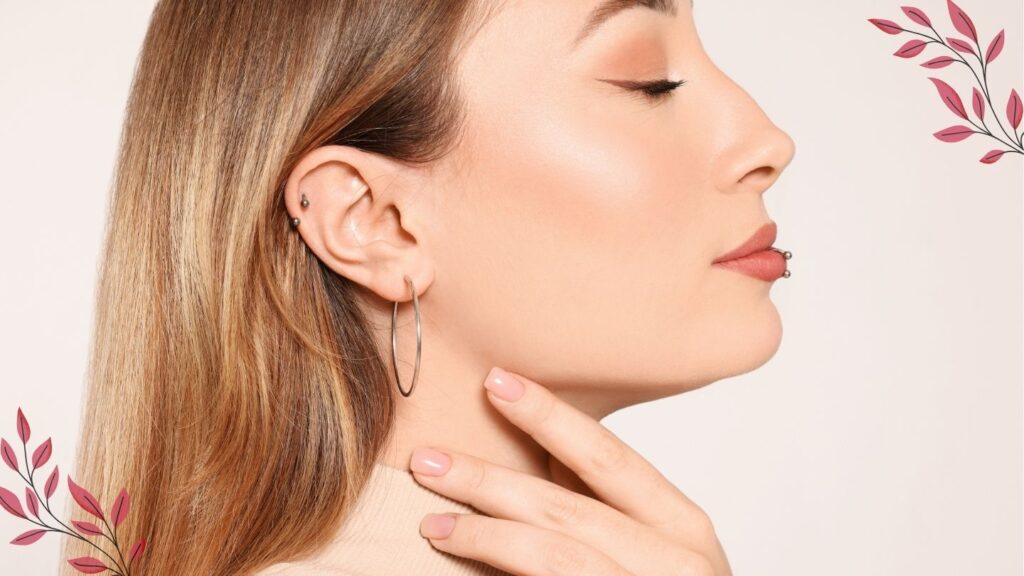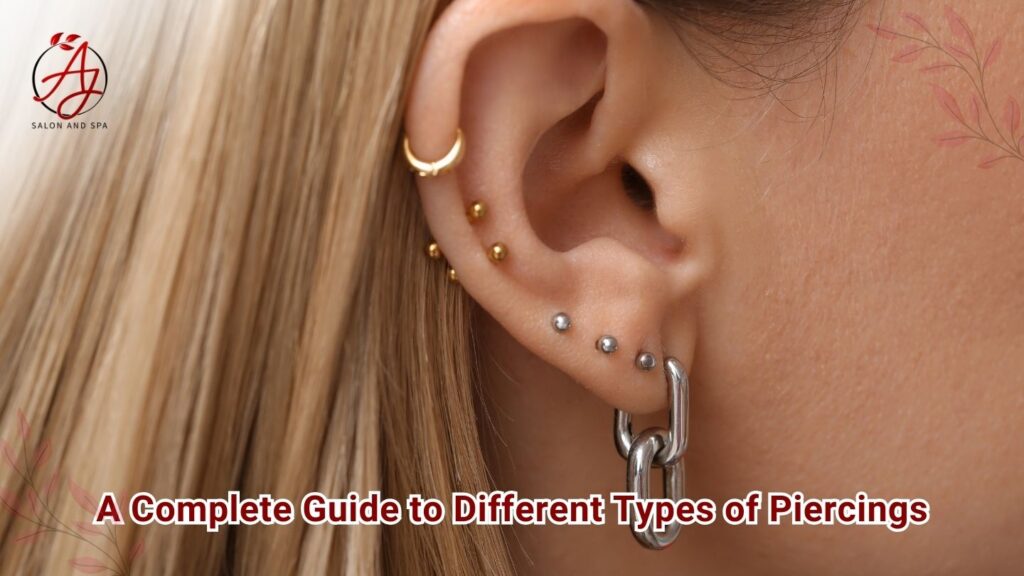Introduction
Body piercing, an ancient practice dating back thousands of years, has evolved into a popular form of self-expression. From the delicate, classic appeal of a simple earlobe piercing to the bold aesthetic of a septum or industrial piercing, there are countless ways to personalize your look and showcase your individuality. Piercings today are not only about fashion but also represent a unique blend of personal history, cultural heritage, and modern trends. At AJ Salon and Spa, we are passionate about the art of piercing and dedicated to providing a professional, safe, and personalized experience. We believe that every piercing is a powerful statement, and our experienced team is here to help you make informed choices, guide you through aftercare, and answer any questions to ensure you enjoy your piercing journey with us.
This guide will explore the many types of piercings available today, each offering unique placements, styles, and ways to enhance your body’s natural beauty. Whether you’re a first-timer looking for a subtle ear piercing or an enthusiast planning to add an intricate facial or body piercing, this comprehensive guide is here to help you decide which type best aligns with your taste and lifestyle.
Ear Piercings
Ear piercings are incredibly popular, partly due to their versatility and range of options for both beginners and seasoned enthusiasts. The most common ear piercing, the earlobe piercing, is often the first experience for many. This classic choice has a relatively quick healing time, typically between six to eight weeks, and suits a variety of jewelry, from studs and hoops to dangles and elaborate pieces. For those seeking a unique look, multiple lobe piercings allow for stacking jewelry along the lobe, creating a customized and stylish design that can be changed with different jewelry styles.
Another distinctive choice is the transverse lobe piercing, which deviates from the traditional vertical alignment and instead passes horizontally through the earlobe. This placement generally requires a longer barbell, which accommodates the width of the earlobe and may have an extended healing period due to the unusual orientation. Those with this piercing often appreciate it for its modern twist on the traditional lobe piercing, offering a fresh take on an otherwise classic location.

Cartilage Piercings
Cartilage piercings are a popular choice for those seeking to elevate their ear aesthetics with unique placements and versatile jewelry options. Unlike lobe piercings, cartilage piercings are done on the firmer tissue in various parts of the ear, from the upper rim to the inner folds, creating a layered and dynamic look. The helix piercing, placed along the upper outer ear, is often the first cartilage piercing many choose for its understated elegance and flexibility with different jewelry styles, including hoops, studs, and cuffs. For a more distinctive look, the forward helix sits on the outer rim near the face and is often done in multiples, creating a cascading effect that pairs beautifully with dainty or gem-studded jewelry. The industrial piercing, known for its bold, statement appeal, connects two cartilage points with a single barbell, often across the upper ear, adding a unique and edgy dimension to one’s style.
Other cartilage piercings include inner placements like the tragus, located on the small flap of the cartilage covering the ear canal, and the daith, nestled in the ear’s innermost fold. These inner ear piercings offer a subtle yet trendy style, with options for small hoops and studs that suit each location’s shape. The rook piercing, situated on the cartilage fold above the daith, provides a distinctive look when paired with curved barbells or captive bead rings. For those seeking more unconventional styles, the snug and conch piercings are excellent choices, with the snug positioned along the inner ridge and the conch offering space for larger hoops that encircle the outer ear. Each cartilage piercing requires a bit more aftercare than lobe piercings due to the density of cartilage, but the striking results make the investment in care well worth it.
Facial Piercings
Facial piercings add unique character to one’s appearance, making a bold statement while accentuating natural features. The nose piercing is one of the most widely embraced facial piercings, with its origins rooted in cultural traditions worldwide. The nostril piercing is versatile, accommodating studs, hoops, and more elaborate pieces, and it typically heals within two to four months. A variation, the high nostril piercing, is placed higher on the nostril bridge and often requires specialized jewelry due to its location. For a bolder option, the septum piercing passes through the thin tissue between the nostrils, offering an edgy aesthetic that can be easily hidden by flipping the jewelry upward when needed.
The bridge piercing offers a unique placement across the nose bridge and between the eyes and is a striking option for those with a flair for non-traditional piercings. This placement requires anatomical consideration, as it can be prone to migration and should only be performed by a highly experienced professional. A more advanced choice is the nasallang piercing, which pierces both nostrils and the septum in a single, straight line. Known for its symmetrical and visually impactful look, this piercing is complex and recommended for those experienced with piercings.
Eyebrow and Lip Piercings
The eyebrow piercing is a stylish way to emphasize facial features, and it can be placed vertically or horizontally along the eyebrow ridge. Customizable with various jewelry types, such as curved barbells or rings, this piercing offers an edgy aesthetic that can range from subtle to statement-making. Lip piercings also provide versatility and come in many styles, each creating a unique aesthetic. The labret piercing, positioned centrally below the bottom lip, is a popular choice for its symmetrical appearance. Variations include the vertical labret, which runs vertically through the lip, with both ends visible, adding a distinctive twist to the traditional labret.
Named after iconic beauty marks, the Monroe (left side) and Madonna (right side) piercings add a touch of glamour above the upper lip. Centered on the philtrum between the nose and upper lip, the Medusa piercing creates a striking, balanced appearance that can be paired with decorative studs. For a more symmetrical look, the angel bites (two piercings above the upper lip on either side) and snake bites (two piercings below the lower lip) offer dramatic styles that suit those seeking bold symmetry. Each of these placements accommodates various jewelry, allowing individuals to switch between styles for a versatile, expressive look.
For hidden piercings, lip frenulum piercings, like the smiley piercing (upper lip frenulum) and frowny piercing (lower lip frenulum), are fun, discreet options. These piercings are only visible when the person smiles, providing a subtle yet playful effect that adds to the uniqueness of one’s look.

Oral Piercings
Oral piercings, especially tongue piercings, require specific aftercare due to their location within the mouth. The standard tongue piercing is vertically positioned through the tongue’s center, typically accommodating barbells and rings. Healing generally takes four to six weeks, but oral hygiene is crucial to prevent infections due to constant moisture. For a more discreet option, the tongue web piercing is located on the thin tissue under the tongue, known as the lingual frenulum, and is generally less noticeable. Although horizontal tongue piercings are possible, they involve more complexity and higher risks, making them less common.
Body Piercings
Body piercings encompass a variety of placements beyond the face and ears, allowing individuals to accentuate other parts of the body. The navel piercing (or belly button piercing) is particularly popular and is often adorned with decorative charms, gemstones, or minimalist rings. Positioned just above the belly button, it requires special care due to the movement of the abdominal area, with healing times ranging from six months to a year.
Nipple piercings are suitable for both men and women, and they can be placed horizontally, vertically, or diagonally to accommodate various aesthetic preferences. Known to enhance sensitivity, nipple piercings are often kept private, adding a personal element to one’s collection of body art. For those interested in flat surface piercings, surface piercings on areas like the collarbone, hips, or nape of the neck are becoming more popular. Unlike traditional piercings, dermal piercings involve a single anchor point beneath the skin and can be placed almost anywhere, providing a unique and striking look. Both surface and dermal piercings require meticulous aftercare due to the higher likelihood of rejection.
Genital Piercings
Genital piercings are chosen for both personal and aesthetic reasons. They vary greatly in terms of placement and purpose, often enhancing personal intimacy or adding a unique, private element to one’s body art collection. Due to their sensitive nature, genital piercings should only be performed by highly skilled professionals in a sterile environment to ensure safety. Healing times and aftercare needs vary considerably depending on the specific piercing.
Aftercare and Healing
Aftercare is crucial for maintaining a healthy piercing and avoiding infections. Follow these key guidelines for aftercare:
- Clean regularly: Clean your piercing twice daily with a saline solution or aftercare spray recommended by your piercer. Avoid alcohol-based products as they can dry out and irritate the area.
- Limit handling: Wash your hands before touching the piercing to avoid introducing bacteria, and avoid unnecessary handling to minimize the risk of infection.
- Leave jewelry in place: Don’t remove jewelry until the piercing is fully healed. Premature removal can lead to closure or introduce bacteria to the wound.
- Avoid swimming and exposure to contaminants: Stay out of pools, hot tubs, and natural bodies of water during the healing period. Contaminated water can introduce harmful bacteria to the piercing.
For oral piercings, use a non-alcoholic, antimicrobial mouthwash after eating or drinking, and avoid smoking and excessive alcohol consumption, as these can delay healing.

Healing Times
Each piercing type has a unique healing time. Here’s a general overview:
- Earlobe Piercings: 6-8 weeks
- Cartilage Piercings: 3-12 months
- Facial Piercings: 6-12 weeks
- Oral Piercings: 4-6 weeks
- Navel Piercings: 6 months to 1 year
- Nipple Piercings: 6-12 months
- Surface and Dermal Piercings: Up to 1 year
- Genital Piercings: 4 weeks to 6 months
Be mindful of any signs of infection, such as excessive redness, swelling, pain, unusual discharge, or fever. If any of these symptoms appear, consult your piercer or a healthcare professional for advice.
Choosing the Right Piercing for You
When selecting a piercing, consider factors like your personal style, pain tolerance, and any professional requirements. While some piercings can be easily concealed, others may require adjustments based on your workplace’s appearance policies. It’s also important to ensure that your chosen piercing suits your anatomy; not all placements are feasible for every individual.
Choosing high-quality materials for your jewelry is essential. Options like surgical steel, titanium, and gold reduce the risk of allergic reactions and support better healing. If you’re interested in multiple piercings, AJ Salon and Spa offers personalized consultations to help you explore the options and choose placements that align with your lifestyle and preferences.
Conclusion
Body piercing is a timeless and versatile art form that empowers individuals to showcase their style and personality. With options ranging from classic earlobe piercings to intricate dermal placements, there are styles to suit every aesthetic. At AJ Salon and Spa, we are committed to delivering a safe, professional, and enjoyable piercing experience, helping you find the perfect piercing to complement your unique look.
Are you ready to explore the world of piercings? Discover our piercing services in Naperville and find the style that suits you best. Visit us at AJ Salon and Spa to learn more about our offerings and to book an appointment with one of our experienced piercers. with one of our experienced piercers. Whether it’s your first piercing or an addition to your collection, we’re here to guide you every step of the way.
Frequently Asked Questions
How Long Does It Take for Cartilage Piercings to Heal?
Cartilage piercings generally take longer to heal than lobe piercings due to the density of cartilage tissue. While each person’s healing time can vary, most cartilage piercings require between 3 to 12 months to fully heal. During this period, it’s essential to follow proper aftercare, including regular cleaning with a saline solution and avoiding unnecessary handling or changing jewelry too soon.
Are Cartilage Piercings Painful?
Cartilage piercings are typically more sensitive than lobe piercings, as cartilage is firmer and less flexible. Most people describe the pain as a sharp pinch followed by soreness, but it is generally tolerable. Pain levels can vary depending on the specific area and individual pain tolerance. Pain usually subsides quickly after the piercing and decreases significantly within the first few days.
What Types of Jewelry Are Best for Cartilage Piercings?
The best jewelry for cartilage piercings includes materials that are hypoallergenic, like surgical steel, titanium, or 14K gold. For initial healing, studs or small hoops are ideal since they limit movement and reduce irritation. Once the piercing has healed, you can explore a variety of options, including cuffs, rings, or barbells, to suit your style.


